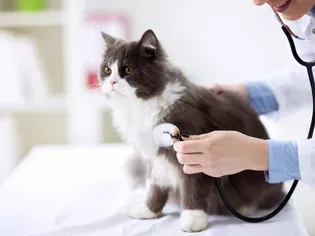Toxoplasmosis in Cats
Updated on 05/26/24

Toxoplasmosis in Cats: A Comprehensive Guide for Cat Owners
Introduction: Unveiling the Hidden Danger
Toxoplasmosis is a common parasitic infection that can affect cats and humans alike. While it often goes unnoticed in cats, it can pose serious health risks to both feline and human companions. This comprehensive guide will delve into the complexities of toxoplasmosis in cats, empowering you with essential information to protect your beloved pet and safeguard your family's well-being.
Understanding Toxoplasmosis: The Parasite and Its Transmission
Toxoplasmosis is caused by a single-celled parasite known as Toxoplasma gondii. Cats play a crucial role in its lifecycle as they are definitive hosts for the parasite. After ingesting infected prey, such as rodents or birds, cats shed oocysts, the infectious stage of the parasite, in their feces. These oocysts can survive in the environment for months, posing a potential risk to other animals and humans.
Prevalence and Clinical Signs in Cats
Toxoplasmosis is widespread among cats, with an estimated prevalence of 20-50% in certain regions. However, the majority of cats remain asymptomatic, showing no outward signs of infection. In some cases, cats may develop mild clinical signs, including:
* Fever: Elevated body temperature
* Lethargy: Lack of energy and interest
* Loss of appetite: Refusal or reduced food intake
* Respiratory signs: Coughing or difficulty breathing
* Neurological symptoms: Seizures or wobbly gait (ataxia)
Diagnosis and Treatment: Essential Steps for Recovery
If you suspect your cat has toxoplasmosis, prompt veterinary attention is crucial. Your veterinarian will conduct a thorough physical examination and review your cat's medical history. Diagnostic tests, such as blood tests and fecal examinations, may be recommended to confirm the diagnosis.
Treatment for toxoplasmosis typically involves a course of antibiotics, often a combination of pyrimethamine and sulfadiazine. The duration of treatment may vary depending on the severity of the infection and your cat's individual response. It is important to complete the entire course of antibiotics as prescribed to ensure effective eradication of the parasite.
Prevention: Protecting Your Cat and Your Family
Prevention is key in safeguarding your cat and family from toxoplasmosis. Here are some essential measures you can take:
* Regular deworming: Administering regular dewormers to your cat can help prevent infection by eliminating other parasites that may carry Toxoplasma gondii.
* Control rodent population: Rodents are common carriers of Toxoplasma gondii. Keep your home and surroundings free of rodents by sealing any entry points and using traps.
* Supervise outdoor cats: Restricting your cat's access to the outdoors reduces the risk of exposure to infected prey.
* Handle cat litter with care: Oocysts are shed in cat feces. Wear gloves and thoroughly wash your hands after cleaning the litter box to minimize contact with infective material.
* Wash fruits and vegetables thoroughly: Toxoplasma gondii oocysts can contaminate soil and water. Wash all fruits and vegetables thoroughly before consumption to remove any potential parasites.
Zoonotic Potential: Understanding the Risks to Humans
Toxoplasmosis can be transmitted from cats to humans through contact with infected cat feces or ingestion of contaminated food or water. The risk of infection is particularly concerning for:
* Pregnant women: Infection during pregnancy can lead to miscarriage, birth defects, or other serious complications in the developing fetus.
* Immunocompromised individuals: Individuals with weakened immune systems, such as those undergoing chemotherapy or organ transplants, are at an increased risk of severe toxoplasmosis.
For Pregnant Women: Essential Precautions
If you are pregnant or planning to become pregnant, it is crucial to take the following precautions:
* Avoid contact with cat feces: Wear gloves and thoroughly wash your hands after cleaning the litter box.
* Wear gloves when gardening: Toxoplasma gondii oocysts can survive in soil for months. Wear gloves when gardening to protect yourself from contact with contaminated soil.
* Wash fruits and vegetables thoroughly: Wash all fruits and vegetables thoroughly before consumption to remove any potential parasites.
* Cook meat thoroughly: Cook all meat thoroughly to an internal temperature of 145°F (63°C) to kill any potential Toxoplasma gondii oocysts.
Conclusion: Empowering Cat Owners with Knowledge
Toxoplasmosis in cats is a complex infection that requires careful management to protect both feline and human health. By understanding the parasite's transmission, clinical signs, and diagnostic and treatment options, as well as implementing preventive measures, you can minimize the risks associated with toxoplasmosis. Remember, early detection and treatment are crucial for the well-being of your cat. If you have any concerns about toxoplasmosis, do not hesitate to consult with your veterinarian. Together, let us safeguard the health of our beloved companions and our families.
Explore More Pets

Cat Behavior Problems
How to Stop Aggression in Kittens

Long-Haired Cat Breeds
Siberian Cat: Breed Profile, Characteristics, & Care

Cat Behavior Problems
How to Stop Kittens From Scratching and Biting

Long-Haired Cat Breeds
Turkish Angora: Cat Breed Profile, Characteristics & Care

Basic Training
How to Socialize Your Kitten

Short-Haired Cat Breeds
Cute Pictures & Facts About Calico Cats & Kittens

Litter Box Training
Training Your Kitten to Use the Litter Box

Long-Haired Cat Breeds
10 Fun Facts About White Cats
